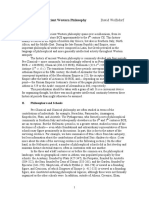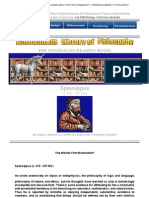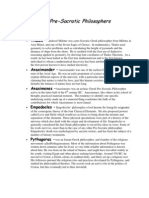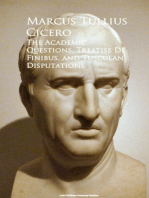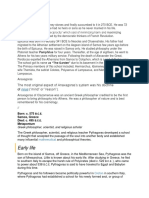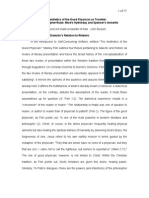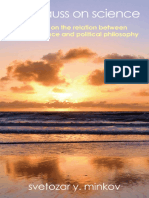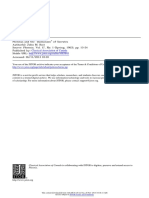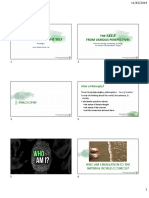Plato, Reader, Writer and Professor
Plato, Reader, Writer and Professor
Uploaded by
Giofer BantocCopyright:
Available Formats
Plato, Reader, Writer and Professor
Plato, Reader, Writer and Professor
Uploaded by
Giofer BantocOriginal Description:
Original Title
Copyright
Available Formats
Share this document
Did you find this document useful?
Is this content inappropriate?
Copyright:
Available Formats
Plato, Reader, Writer and Professor
Plato, Reader, Writer and Professor
Uploaded by
Giofer BantocCopyright:
Available Formats
Plato, Reader, Writer and Professor
EMILIE F. KUTASH
Suffolk County Community College
Selden, New York
Boston University Center for the History and Philosophy of Science
eeekut@optonline.net
Many of us picture Plato as a latter day Socrates, wandering around Athens discussing
philosophy in dialogue with interested parties of his time. Some picture him as playwright of
dramatic dialogues. One school of philosophy considers him the holder of an obscure and cryptic
unwritten doctrine of the One. In actuality Plato was a prose writer, probably an avid reader and
certainly a lecturing and mentoring professor who influenced many of the scholars, mathematicians
and astronomers of his time. At some time between the 380s and 360s B.C.E. Plato founded an
academy which he led until his death when his nephew Speussipus succeeded him. Aristotle stayed
there for twenty years. The academy attracted students and intellectuals from all over Greece. Plato
was also a dedicated prose writer. He held knowledge of a wide range of preexistent literature and
crafted a language suitable for philosophy. Whether or not the Academy had its own library is a
matter of debate. Books were read aloud as well as read silently. Whichever the case, Plato was
strongly influenced by Ionic prose in both technical terminology and in style, as Denniston points
out.
.
There has been a great deal of discussion about the shift from myth to logic, oral to written
tradition that is alleged to have taken place in Ancient Greece. These views presume that there was
an intellectual revolution. Polymaths, however, thrived as early as the sixth century. Prose
literature is not equivalent to the oral exchanges that occur in conversation or in literature meant
for performance. It is composed for serious study while performance and rhetorical compositions
are designed to be spoken at public sessions. The sheer scope of Platos integration of previous
literature suggests that he had access to texts to examine and reexamine. It seems implausible that
he could have utilized such a wide range of material based only on oral exposure. Books, after all,
were increasingly composed to be read as time went on. Plato wrote and taught during the height of
the fourth century; a cosmopolitan intellectual milieu.The premise that Plato, as scholar, read and
read widely merits examination. Despite the reservations about writing that Plato has Socrates
express in Phaedrus 274b-277a, Plato himself was likely a reader with a range of literature
available to him. In fact, some of his perceptions of the inadequacy of writing probably came from
his own struggle to perform a transforming alchemy on a language that heretofore had a limited
philosophical conceptual lexicon. Intent upon philosophical priorities, he worked hard to force the
extant coinage to fit his restless inquiries. It is well known that poetry had a large influence on Plato
as did mythology. I contend that for Professor Plato, technical, scientific and historical prose
writing were just as important if not more so. The international language-literary Ionian-was used
about 425, the time of Platos birth, by learned men of diverse origins in Sicily, Asia Minor, the
Aegean islands, northern Greece, both Ionians and Dorians. Ionian intellectuals, Cole explains,
were widely scattered throughout the islands and coasts of the Aegean and had limited
opportunities for coming together for the exchange of ideas. If the research or speculation
conducted in Miletus or Ephesus were to be made available to other areas there would have to be
texts for consultation and reading.
This type of text existed from the sixth century. Cole argues that
these writings abandoned poetic meter and diction and became more obviously a written prose,
composed to be studied and deciphered by the eye as well as heard by the ear. He bases this
observation on the compactness, precision, regularity and complexity that he finds in late fifth
century texts. The idea that Greek literature was essentially an Oral Tradition has been debunked
by recent scholars. Greece was a literate society well before Platos time. The majority of Athenian
citizens were literate not only during Platos time but from the end of the sixth century B.C. There
are at least nine known writers who fall into he late sixth and first half of the fifth century and a
second group contemporary with Herodotus and Thucydides who wrote treatises. Pherecydes of
Syros, Anaximander, Anaximenes and Hecataeus all wrote books in prose before
Herodotus Histories. By 430 there were eight or nine nature philosophers alone whose books were
available.There were libraries and book stores as well. Xenophon ascribes a library to Euthydemus
(Mem. 4.2). Euripides (fl ca 445 BCE) is lampooned as a bibliophile in Aristophanes Frogs and
apparently had a personal library as well. In Aristophanes (fr. 580) an apprentice, Cephisophon is
identified as one who may have assisted Euripides in the actual production of books. Reading and
writing, then, was common place in the fifth and fourth centuries and probably earlier. Turner
contends that the excavations in the Athenian agora of large quantities of ready made ostraca with
incised lettering (as well as on Athenian vases) documents general literacy. Plato himself in
Laws(810) alludes to the elementary education of children. Reading and writing, he remarks, is
taught at the age of ten but speed in calligraphy is not encouraged until later. It seems that writing
was an everyday thing in Athens and elsewhere in Greece and a normal part of everyday Athenian
education. Platos own citations regarding the easy use of books are instructive. In Apology we
learn that Anaxagoras cosmological treatise could be bought for one drachma from the stalls in the
market (Apol. 26d-e). Zenos appearance in Athens with his written composition (grammata) in
hand at the beginning of Parmenides documents a matter of fact use of texts. If one accepts the
authenticity of Diogenes Laertius, he reports that according to some authorities Plato wrote to Dion
and persuaded him to purchase three Pythagoretreatises from Philolaus for 100 minae and from
these texts he wrote Timaeus. In Phaedo (98b4-6) Socrates is described as having such high hopes
for Anaxagoras books to enlighten him on astronomy and physics that he made haste to get hold
of the books and read them as quickly as I could.
Plato has Critias mention writings concerning
the meaning of names that were in the possession of his grandfather and which he now owned.
In Hippias Minor, there is a description of Hippias arriving at the Olympian festival; carrying poems,
epics, tragedies, dithyrambs and all sorts of prose works (368c11-d1) At the beginning
of Theatetus Eucleides presents Terpsion with a book (biblion) in which he wrote the conversation
he had with Socrates. He describes it as corrected and edited for awkward constructions. Phaedrus
has been trying to memorize Lysias erotic speech from the book he is holding beneath his cloak.
In Laws (811e5), the educator is to select appropriate material for the lessons in literature. Many of
the early authors were polymaths with expertise in, astronomy, cosmology, architecture, medicine
and mathematics. The separate disciplines were not clearly delineated from one another as they are
today. In architecture for example, Anaximander is said to be the author of the first specifically
philosophical book in prose (c. 548-547 BCE). During this same period Theodorus (the architect of
the archaic Samian Heraion) and Chersiphron/Metagenes wrote practical guides aimed at temple
builders. Medicine had its own literature as well. Thomas Cole differentiates between texts such as
the speeches of Antiphon and Thucydides and reference texts for consultation. The reference texts
supply information for those who need expert technical advice or opinion and who could not
consult an expert in person.
He contends that reference texts such as these were produced in some
abundance. The content of many writings was far too complex to digest in a single performance
and thus did not belong to the oral tradition. A reading Plato would have in his repository of
technical writings; the medical works of Hippocrates, the geography and cartography of
Anaximander, architectural and mathematical treatises as well as works on the musical
canon. The Greek polymath writing technical books displayed interests in a wide range of
subjects. Eudoxus, in the fourth century, entitled his book On Speeds, and explained how he was
able to calculate the periods of the planetary revolutions without error. In the arts there was
literature as well. Vitruvius reports that there was work on perspective and reports that an
Agatharchus, a painter of stage scenes at Athens during Aeschylus time had left a treatise on the
subject. There are several books of which we have mostly titles: Sophocles, On the Chorus;
Ictinus, On the Parthenon; Polyclitus, On the Symmetry of the Human Body, Meton, On the
Calendar and Hippodamus, On Town Planning are examples.Musicology is one technical field that
yielded substantial speculation related to the cutting of the Kann, that is, the techniques necessary
to achieve harmony in the musical scale. Archytas and Philolaus, predecessors of Plato, both
discussed this. Plato incorporates the divisions of the Kann and converts them to a theory of ratio
and proportion in Timaeus and he regards proportion as the kind of universal mathematics that
determines the whole structure of material creation. Plato chooses continuous geometrical
proportion, as the most perfect bond to connect four solid bodies forming the whole body of the
world. These bodies, four of the regular solids fit into the fifth, the dodecahedron which is the
universe as a whole. While the figures do not correspond to the construction of a musical scale with
any accuracy, ratio and proportion are seen as a kind of universal mathematics providing Plato with
a paradigm for application to the Physical world. Like scientists and scholars of Physics of the
future Plato is applying mathematical formulas to the physical worldAstronomy is a large influence
on Plato. Eudoxus Phenomena and Henoptron (The Mirror presumably a descriptive image of the
heavens) were contemporary works that probably were in wide circulation. Texts produced
shortly after Platos time, texts such as Theodosius Sphaerica, Autolycus De sphaera quae
movetur (the Rotating Sphere) (De ortibus et occasibus (Risings and Settings) and
Euclids Phaenomena reflect the disciplines of Astronomy as it was in Platos time. These texts did
not spring up entirely unprecedented since the Republic written before the year 370 B. C. was not
far off in time from their publication. Berggren suggests that scholars believe there was an earlier
work that Euclid and Autolycus relied on. This work must have appeared around 360 and 320
BCE. Platos extensive use of Astronomy contributes to the figures of speech with which he
formulates all sorts of philosophical ideas. In Laws (897c5-9) Plato makes the analogy of right
reason and the perfect circular motion that is found in the heavens. The circle of the 'Same' and the
'circle of the Other' of Timaeus are modeled on the ecliptic and equator. It seems that all the
developments in the area of astronomy that studied circular motion were sources of inspiration to
Plato. Eschatological /cosmological imagery based on Astronomy continues in Timaeus,
Epinomis and Laws. The kind of careful study that Plato made of astronomy and the detailed regard
with which he held the scientific terminology of the astronomers could well support an argument
that he made use of written texts Geography and cartography were also burgeoning fields. A
circular boundary for the world was a common way of depicting the known world. It is found in
Homers Iliad (Shield of Achilles) and in the round map of the known world, first devised by
Anaximander,with its circular limits. Star maps and armillary spheres were circular as well. The
idea that the inhabited earth or known world is contained by bounding limit suggests a conceptual
map of inner and outer geographical space. In these accounts the world is seen in the form of an
organized totality for the first time. In both mythical (Myth of Er of Rep.617a-c) and in
philosophical accounts Plato presents a universe that is a limited bounded whole. It is found in
Timaeus (33b1-8) where the universe is one in which the sphere is the fitting shape for the
containment of all things. It is perfect and self similar. Architecture is an area that engendered
prose writing from the sixth century on. Theodorus, Rhoikes, Chersiphron and Metagenes,
contemporaries of Anaximander, wrote prose works. Aristotle gives a detailed account of
Hippodamus of Miletus, the mid fifth century city planner who rebuilt Rhodes in 404 and laid out
the Piraeus as well as other ambitious projects in city planning suggesting his treatises were
available centuries later. Hahn points out those making drawings, building models, diverting rivers,
inventing tools and applying geometrical techniques all utilized theories of proportions. The
column is a good example of the transposition of a technical architectural feat to a literary
component of Platos model of the cosmos. The column in monumental temple architecture has a
cosmic significance as it symbolically separates and joins heaven and earth. In the myth of
Eof Republic, (Rep. 616b-c) Plato describes the cosmos as suspended on a column-like axis. In doing
so he makes use of both its technical function and its symbolic significance. Plato use of
architectural analogue goes even further when he conceives of the creator of the world, the so
called Demiurge, creating the cosmos as a technical fabrication. He fabricates the cosmos by
keeping his gaze on the paradigm. Herodotus used the term paradigm, in an architectural reference
to the project of rebuilding the temple of Apollo at Delphi, to refer to a model. It seems Plato was
inspired by the extensive blueprinting and drawing-up of elevation and other type plans and
descriptions in technical writings and the architectural models based on them.The field of medicine
was well advanced and known to Plato. He refers to Hippocrates of Cos in Protagoras (311B-C) and
inPhaedrus (270c1-5). Medical writers associated with the centers of medical training such as Cos
or Cnidus set new standards for causal analysis and rational inquiry, specifically Hippocratic
writers as different from temple medicine and other charlatan (alaxoneia) practices. Platos
standards of valid reasoning and truth may have some precedent in the kind of distinction these
medical writers delineate. In other contexts Plato uses illness as a metaphor for the ignorant soul
and therapies ad medicines are to provide intellectual cures provided they focus on the whole (to
holon) (156d6-157a3).Platos mathematical examples in Republic and Meno and his idea that
mathematics was essential in the training of philosophers is legend. His characters frequently use
mathematical examples. Mathematics for Plato served as an exemplar of stable knowledge and
impressed upon him the possibilities of a universal way of analyzing the physical world. It created,
for him, a vision of the whole that could be rationalized through the application of universal
technical schemata. In Republic (527a6-b2) Plato calls for a study of . . . squaring and applying and
adding and the like, for the sake of pure knowledge. In Timaeus he presents a view of the physical
world that is unified by mathematics. His theory that triangles make up the elements of the physical
world obviously has a geometrical origin.Sr. Thomas Heath and others have contended that the
completed subject matter of many of the books of Euclids Elements were extant in the fifth century,
if not yet compounded by Euclid himself.
Were Plato to possess a library, then, it would certainly
contain mathematical treatises.Finally, mention must be made of the methodological advances that
were achieved by historians. By Platos time there were all sorts of historical books in print. There
were books that traced the genealogies of families who claimed descent from a god or hero,
geographical works in the form of a periegesis or periplous describing areas and people met on a
coasting voyage and accounts of the founding of cities. Hecataeus of Miletus (6
th
to 5
th
c.) relied on
history, his own experience and criticized myth. Thucydides wrote rational and accurate historical
prose representing a rigorous search for truth. Herodotus is a transitional figure who did at times
depend on legend and unverified stories. He himself contrasted his own work with the earlier
writers of chronicles, (logoi) (Hist.2, 99) as more accurate.
35
It was only with Thucydides, however,
that Mythical and imaginary components present in the stories of the poets were rejected in the
name of historical truth.
Plato always insists that myth is distinct from logical analysis and
reiterates this distinction in Protagoras and in Sophist (259d-64b) where he states that standards
of truth and falsity can be applied to logic but not to myth.The last quarter of the fifth century was a
time, as Dennisons book Greek Prose Style documents, of experimentation with language. Prodicus
conducted lectures on the correct use of words and held a complete course on grammar and
language which Socrates calls this the 50 drachma course and contrasts it with the one-drachma
course which was all he could afford and taught him very little. (Crat.384b-c). Antiphon the Sophist
gave lessons on the principles of word formation and new compounds were being formed with
great freedom. Denniston (10) points out that Gorgias and Thrasymachus, as well as other Sophists
exercised considerable influence on Greek prose. Certainly Plato, arch professor of philosophy and
linguistics, was part of this prose creating revolution outdoing theseSophists by seeking criteria for
truth. The process of adapting grammar to new uses for philosophy began with the Pre-Socratics.
The definite article, for example, evolves from the demonstrative pronoun into the generic article as
prose writing develops. Snell points out that the horse in Homer is never mentioned as the concept
of a horse but always a particular horse. In philosophical prose on the other hand, the generic use
of the article is an entrenched fixture. Heraclites speaks of the act of thinking (112;
113) the universal (2; 114) and the logos (tou logou) (fr. 1, fr.50 fr. 2) while Anaximander speaks
of the infinite (to apieron).
The definite article helps to substantiate an abstract entity and promote
it to the status of a universal and allow the philosopher to make statements about it as a universal
(The one, the whole, the soul etc.). Plato takes this process to new heights and while Hesiod speaks
of a just act (Works 226, 231) Plato will speak of the just i.e. Justice. Another prime example of
prose innovation is the Parmenidean identification of the copula is with existence. Denniston
points out the very important fact that in the expression of abstract ideas the existing vocabulary
was inadequate and gives numerous examples of Platos prose innovations. One example of a
uniquely philosophic usage is the negative form to m on for Non being.There is also the matter of
definition. When Plato has Socrates ask such questions as: What is Justice? What is virtue? Etc.
Using dialogue as his vehicle, Plato thereby creates a dialectic in which the interlocutors establish
grounds for a philosophical definition, beginning with placing the object of definition within a class
structure.
Written compositions must adhere to an ideal of definable permanent truths as opposed
to contradictory and unverifiable verbal usages that one might find in oral presentations. These are
endeavors to fix meanings in an era preceding the invention of dictionaries. Doing so is crucial to
successful written communication andteaching.
.
Plato the professor and master prose innovator
discussing concepts with abstract referents such as justice or good subjected these words to
consistent norms.Finally we look at Plato the Professor. There is documentation of Platos famous
lecture on the Good which was never written but reported on in subsequent literature. This could
not be his only public lecture. Aristotle as avid pupil in the Academy possessed a full knowledge of
his doctrines and it is hard to believe that Plato did not regularly discourse on the many matters of
which he wrote. Platos high regard for rigorous proof, investigative inquiry, definition and self
conscious methodology were academic standards held by Plato the professor as well as
philosopher. There has been a great deal of speculation in the literature about just what sort of
Academy Plato ran and little actual external evidence to quell this speculation.. Platos standards for
an ideal educational curriculum, however, are legend and documented in Republic VII where he
presents a plan for higher education in the ideal society which includes the education of woman.
In Laws as well, he proposed educational requirements which included plane and solid geometry,
mathematical astronomy, harmonics and dialectic. One piece of evidence cited by Harold Cherniss
(65) concerning the educational program of the Platonic school was the first century history of the
Platonic School given by Philodemus where he says that Plato formulated problems which the
mathematicians investigated. Proclus (5
th
century C.E.Athenian School) in his summary of history of
mathematics names Theatetus, Leodamas , Philop of Opus and six specialists in mathematics that he
claims passed time together in the Academy pursing common investigations. Another citation by
Harold Cherniss (63) is the fragment from a comedy of Epicrates in which someone asks what Plato,
Speussipus and Menedemus are up to these days and in reply the interlocutor says that he saw, in
the gymnasium of Academia, a group of lads defining the kinds of animals and plants and bending
over a gourd trying to classify it with Plato standing by to guide them. Cherniss remarks that this
does not document the study of natural science in the Academy but does show that Plato
encourages his students to frame precise definitions. Plato, Reader, Writer and Professor wrote and
published, read widely, and conducted all sorts of intellectual investigations with his followers and
pupils. He did not ignore the more technical fields in his pursuit of forging an appropriate language
for philosophy. It does not do justice to Plato as professor to view him only as holding esoteric
unwritten and obscure doctrines or as writing dramas or as a peripatetic wandering around
Athens. Speculation about what Plato might have read, the teaching and mentoring he did, and the
prose crafting he spent time on, allows us to place Plato more squarely in the academic milieu of
sixth to fourth century Greece.
You might also like
- Wisdom in Classical and Biblical Tradition Michael C Legaspi All ChapterDocument67 pagesWisdom in Classical and Biblical Tradition Michael C Legaspi All Chapterjohn.eusebio964100% (21)
- F.E. Peters.-Greek Philosophical Terms - A Historical Lexicon-New York University Press (1967) PDFDocument124 pagesF.E. Peters.-Greek Philosophical Terms - A Historical Lexicon-New York University Press (1967) PDFOo100% (5)
- MacDowell, Douglas M., Hybris in Athens, G&R, 23, 1 (1976), Pp. 14-31Document19 pagesMacDowell, Douglas M., Hybris in Athens, G&R, 23, 1 (1976), Pp. 14-31rmvicentinNo ratings yet
- What Did Plato ReadDocument20 pagesWhat Did Plato ReadMaria SozopoulouNo ratings yet
- Socrates: PlatoDocument4 pagesSocrates: PlatolenerNo ratings yet
- Ancient PhilosophersDocument20 pagesAncient PhilosophersElaissa MoniqueNo ratings yet
- Heid Anaximander FragmentDocument46 pagesHeid Anaximander FragmentCarlos Tresmesino100% (1)
- Ancient Western Philosophy OverviewDocument7 pagesAncient Western Philosophy OverviewMMHCNo ratings yet
- Understanding The Self: ASSIGNMENT #4 - Sept. 5, 2019Document4 pagesUnderstanding The Self: ASSIGNMENT #4 - Sept. 5, 2019Jonah Garcia TevesNo ratings yet
- Theology in Philosophy The Case of The Late Antique Neoplatonist Damascius by Androniki KalogiratouDocument11 pagesTheology in Philosophy The Case of The Late Antique Neoplatonist Damascius by Androniki KalogiratouandronikkieNo ratings yet
- Individual (In Reality and in Knowledge) From The Universal. Aristotle, Judging That Plato'sDocument25 pagesIndividual (In Reality and in Knowledge) From The Universal. Aristotle, Judging That Plato'ssjNo ratings yet
- Aristotle in Byzantium: Klaus OehlerDocument14 pagesAristotle in Byzantium: Klaus OehlerMihai FaurNo ratings yet
- Socrates BiographyDocument4 pagesSocrates BiographyScribdTranslationsNo ratings yet
- From Ta Metá Ta Physiká To Metaphysics Piotr Jaroszyński: Espíritu LXII (2013) Nº 145Document25 pagesFrom Ta Metá Ta Physiká To Metaphysics Piotr Jaroszyński: Espíritu LXII (2013) Nº 145Berk ÖzcangillerNo ratings yet
- Plato N Aristotle 2Document36 pagesPlato N Aristotle 2Hafsa AhmedNo ratings yet
- Book of The SoulDocument41 pagesBook of The SoulScribdTranslationsNo ratings yet
- Apollonius of PergaDocument21 pagesApollonius of Pergahasan jamiNo ratings yet
- Speusippus - What Is Known About The First Nominalist - Athenaeum Library of PhilosophyDocument8 pagesSpeusippus - What Is Known About The First Nominalist - Athenaeum Library of PhilosophyRami TouqanNo ratings yet
- Plato's Four Muses The Phaedrus and The Poetics of Philosophy by Andrea Capra PDFDocument3 pagesPlato's Four Muses The Phaedrus and The Poetics of Philosophy by Andrea Capra PDFAron Barcelos0% (1)
- Greek Presocratic Philosophers and Sophists: A Short IntroductionFrom EverandGreek Presocratic Philosophers and Sophists: A Short IntroductionNo ratings yet
- AssignmentDocument3 pagesAssignmentVladimir LegisNo ratings yet
- Aristotle 1Document6 pagesAristotle 1Giancarlo MartinoNo ratings yet
- Dialogues of Plato - Alexander WilderDocument103 pagesDialogues of Plato - Alexander WilderMark R. JaquaNo ratings yet
- AARONDocument6 pagesAARONapi-26570979No ratings yet
- Aristotle (384-322 BCE) : Ancient Greek Philosophy Ethics PlatoDocument16 pagesAristotle (384-322 BCE) : Ancient Greek Philosophy Ethics PlatoFarooq RahNo ratings yet
- AriesofpalaceDocument6 pagesAriesofpalacestellah.sy1No ratings yet
- LyceumDocument4 pagesLyceumЛеонид ЖмудьNo ratings yet
- Archytas: Author and Authenticator of Pythagoreanism: Phillip Sidney Horky Durham UniversityDocument26 pagesArchytas: Author and Authenticator of Pythagoreanism: Phillip Sidney Horky Durham UniversityOsíris MouraNo ratings yet
- Thales Greek Philosophy Notes HighlightedDocument29 pagesThales Greek Philosophy Notes HighlightedAssault FXNo ratings yet
- The Academic Questions, Treatise De Finibus, and Tusculan DisputationsFrom EverandThe Academic Questions, Treatise De Finibus, and Tusculan DisputationsNo ratings yet
- Lecture 8 - Greek Thought - Socrates Plato and AristotleDocument7 pagesLecture 8 - Greek Thought - Socrates Plato and AristotleGabriel LavistaNo ratings yet
- Pericles Also Fostered Athenian Democracy To Such An: Pericles, Prince of Tyre Is A Jacobean Play Written at LeastDocument6 pagesPericles Also Fostered Athenian Democracy To Such An: Pericles, Prince of Tyre Is A Jacobean Play Written at LeastGideon MonteserNo ratings yet
- Horky, Persian Cosmos and Greek PhilosophyDocument58 pagesHorky, Persian Cosmos and Greek Philosophychr_maxmann100% (1)
- Perceiving and KnowingDocument24 pagesPerceiving and Knowingclaudia zattaNo ratings yet
- Thierry of Chartres, Prologue To The HeptateuchonDocument7 pagesThierry of Chartres, Prologue To The HeptateuchonMarcus Adonai Castro da SilvaNo ratings yet
- Proclus: A Commentary on the First Book of Euclid's ElementsFrom EverandProclus: A Commentary on the First Book of Euclid's ElementsRating: 4 out of 5 stars4/5 (1)
- Death: Early LifeDocument14 pagesDeath: Early LifeIrish PenanonangNo ratings yet
- Al-Farabi On Plato and AristotleDocument11 pagesAl-Farabi On Plato and AristotleFiona DuNo ratings yet
- Runia PhiloandPlacitaDocument11 pagesRunia PhiloandPlacitaumityilmazNo ratings yet
- A Selection from the Discourses of Epictetus, with the EncheiridionFrom EverandA Selection from the Discourses of Epictetus, with the EncheiridionRating: 4 out of 5 stars4/5 (9)
- Top Questions: Chalcidice ChalcisDocument22 pagesTop Questions: Chalcidice Chalcishafeez ullahNo ratings yet
- History of Classical PhilologyDocument520 pagesHistory of Classical Philologypetitepik100% (1)
- Aristotle and The Golden MeanDocument19 pagesAristotle and The Golden MeanHashma KhanNo ratings yet
- The Classics, Greek & Latin VOL 1 The Most Celebrated Works of Hellenic and Roman Literature, Embracing Poetry, Romance, History, Oratory, Science, and Philosophy 1909 - Marion M. MillerDocument478 pagesThe Classics, Greek & Latin VOL 1 The Most Celebrated Works of Hellenic and Roman Literature, Embracing Poetry, Romance, History, Oratory, Science, and Philosophy 1909 - Marion M. MillerWaterwind100% (1)
- Estudio Comparativo Fábulas de EsopoDocument38 pagesEstudio Comparativo Fábulas de EsopoAmbar CruzNo ratings yet
- Business Ethics P. 93-104Document3 pagesBusiness Ethics P. 93-104Raez RodilladoNo ratings yet
- Aesthetics of The Good PhysicianDocument27 pagesAesthetics of The Good Physicianjohanna_341529511No ratings yet
- The Age of GreeceDocument20 pagesThe Age of GreeceKALI REICHERTNo ratings yet
- At Play Seriously Irony and Ironic Humor in The VITA of Josephus PDFDocument72 pagesAt Play Seriously Irony and Ironic Humor in The VITA of Josephus PDFਸਾਦੇ ਪਾਗਲNo ratings yet
- Being For Beauty Aesthetic Agency and Value Dominic Mciver Lopes Full ChapterDocument67 pagesBeing For Beauty Aesthetic Agency and Value Dominic Mciver Lopes Full Chaptercarolee.kuehl851100% (7)
- PSIR Test 01 Model AnswersDocument10 pagesPSIR Test 01 Model AnswersJohn AllenNo ratings yet
- Module 8 - Ethical Framework Aristotle's Virtue EthicsDocument10 pagesModule 8 - Ethical Framework Aristotle's Virtue EthicsChristian LaronaNo ratings yet
- (Suny Series in the Thought and Legacy of Leo Strauss) Svetozar Y. Minkov - Leo Strauss on Science_ Thoughts on the Relation between Natural Science and Political Philosophy-State Univ of New York Pr .pdfDocument242 pages(Suny Series in the Thought and Legacy of Leo Strauss) Svetozar Y. Minkov - Leo Strauss on Science_ Thoughts on the Relation between Natural Science and Political Philosophy-State Univ of New York Pr .pdfNiccolo CobradoNo ratings yet
- Richard Feynman On Education in BrazilDocument4 pagesRichard Feynman On Education in BrazilLeonardoNo ratings yet
- Introduction To The Philosophy of The Human Person (1G)Document38 pagesIntroduction To The Philosophy of The Human Person (1G)Trisha May Panaligan SacdalanNo ratings yet
- Ethics Gen IntroDocument27 pagesEthics Gen IntroMarnel ValentinNo ratings yet
- Functions and Philosophical Perspectives of ArtDocument4 pagesFunctions and Philosophical Perspectives of ArtMarla Joy LucernaNo ratings yet
- A Socratic Dialogue On MathematicsDocument16 pagesA Socratic Dialogue On Mathematicsnishtyaki2583No ratings yet
- Philosophical Perspectives: Prof. Kumar Neeraj Sachdev Department of Humanities and Social Sciences 6168-FDocument13 pagesPhilosophical Perspectives: Prof. Kumar Neeraj Sachdev Department of Humanities and Social Sciences 6168-Fshashankmay18No ratings yet
- Jorge Paulo Lemann What I Learned at Harvard PDFDocument4 pagesJorge Paulo Lemann What I Learned at Harvard PDFPattyPattersonNo ratings yet
- John M. Rist - Plotinus and The "Daimonion" of SocratesDocument13 pagesJohn M. Rist - Plotinus and The "Daimonion" of SocratesM MNo ratings yet
- Plato Ideal State.Document31 pagesPlato Ideal State.Yuvraj HarshNo ratings yet
- 2016 Bull CAT 15: Section: Verbal AbilityDocument51 pages2016 Bull CAT 15: Section: Verbal AbilityNagatoOzomaki0% (1)
- Detailed Lesson Plan in Physical Science - mhelDSDocument10 pagesDetailed Lesson Plan in Physical Science - mhelDSsarah fojasNo ratings yet
- Understanding The SelfDocument26 pagesUnderstanding The SelfPatricia Ann JoseNo ratings yet
- Aristippus and Freedom - Kristian Urstad PDFDocument15 pagesAristippus and Freedom - Kristian Urstad PDFDavo Lo SchiavoNo ratings yet
- The Politics of Theogony: James RedfieldDocument6 pagesThe Politics of Theogony: James Redfieldmasanta11No ratings yet
- A Proof in the ΠΕΡΙ ΙΔΕΩΝ Author(s) : G. E. L. Owen Source: The Journal of Hellenic Studies, 1957, Vol. 77, Part 1 (1957), pp. 103-111 Published by: The Society for the Promotion of Hellenic StudiesDocument10 pagesA Proof in the ΠΕΡΙ ΙΔΕΩΝ Author(s) : G. E. L. Owen Source: The Journal of Hellenic Studies, 1957, Vol. 77, Part 1 (1957), pp. 103-111 Published by: The Society for the Promotion of Hellenic StudiesGiorgi MarkozashviliNo ratings yet
- Gagarin 1977 Socrates Hybris - CópiaDocument17 pagesGagarin 1977 Socrates Hybris - CópiaFernanda PioNo ratings yet
- Cain, Shame and Ambiguity in Platos GorgiasDocument27 pagesCain, Shame and Ambiguity in Platos GorgiasmartinforcinitiNo ratings yet
- Aristotles Criticism of The Platonic ForDocument26 pagesAristotles Criticism of The Platonic Formusic cisumNo ratings yet
- Introduction To The Philosophy of The Human Person (1G)Document39 pagesIntroduction To The Philosophy of The Human Person (1G)Trisha May Panaligan SacdalanNo ratings yet
- Lovibond, S., 1991, Plato's Theory of MindDocument12 pagesLovibond, S., 1991, Plato's Theory of MindMcnn100% (1)













